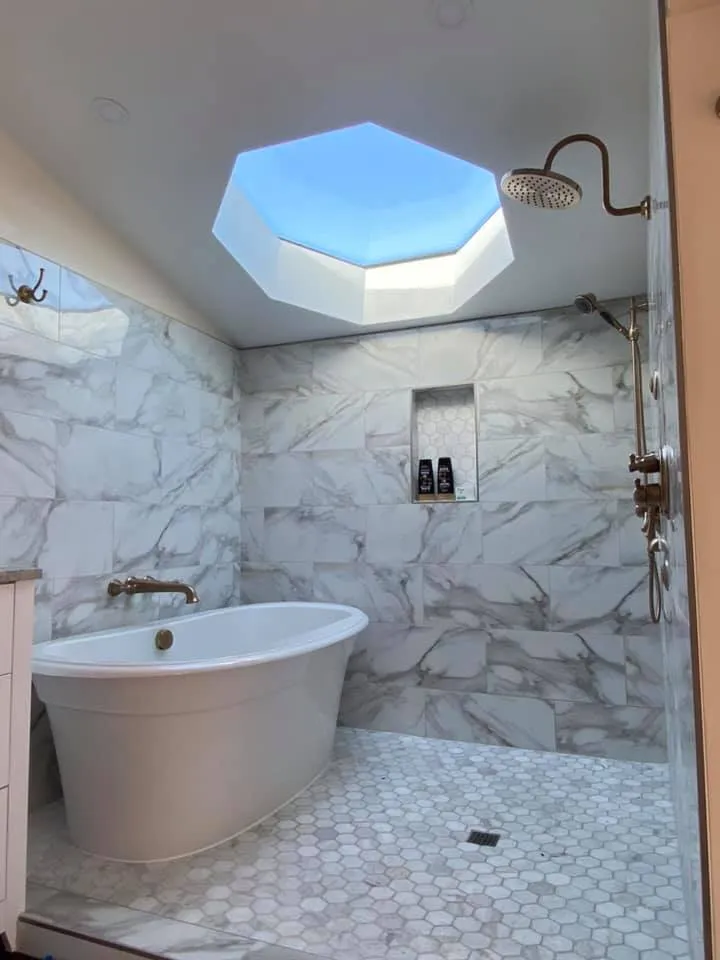
As we age, our needs change and our homes should evolve with us to ensure safety, comfort, and independence. One crucial area that requires special attention is the bathroom. Designing an accessible bathroom using universal design principles is essential for those planning to age in place. This approach makes bathrooms safer and easier to use for everyone, regardless of age or mobility.
This includes features like wheelchair access, accessible showers, and horizontal grab bars. Once simple tasks, like getting in and out of the shower or using the toilet, can become challenging. Accessible design can help address these issues, making daily activities easier and safer.
Mobility issues can affect anyone at any age, but they are especially common as we get older. Arthritis, joint pain, and balance problems can make it difficult to move around. Simple tasks like grabbing handles or turning door knobs can become challenging. This is why accessible bathrooms are becoming more popular. They provide features that help people with mobility issues maintain their independence and safety.
An accessible bathroom is designed to be usable by people of all ages and abilities. It includes features that accommodate those with limited mobility, such as wider doorways, grab bars, and walk-in showers. The goal is to create a space where everyone can maintain their independence and dignity.
Accessible showers and walk-in tubs are essential for an accessible bathroom. These features make it easier for people with mobility issues to bathe without the risk of slipping and falling.
Installing horizontal grab bars in strategic locations can provide support and stability for those who need it. According to ADA guidelines, grab bars should be placed on the sidewalls and the rear wall of the shower or bathtub area.
Having adequate floor space is crucial for wheelchair access. According to the Americans with Disabilities Act (ADA), the bathroom should be designed to allow a wheelchair to turn around easily. This means ensuring there is enough clear space, ideally 60 inches in diameter, to accommodate a full 360-degree turn.
Bathroom doors should be wide enough to accommodate a wheelchair. The ADA recommends that doorways be at least 36 inches wide. Using a pocket door can save space and make it easier for people with mobility issues to enter and exit the bathroom.
The sink area should be accessible from a seated position. This means the sink should be installed at a lower height, with enough clear space underneath for a wheelchair. Handles and faucets should be easy to reach and operate.
Accessible toilets are usually higher than standard toilets. The seat height is typically between 17 to 19 inches from the floor, which is the same height as most wheelchairs. This makes it easier for users to transfer from a wheelchair to the toilet seat.
You can make even a small bathroom accessible when you convert it to a wet room. A wet room is a trendy, accessible and space-saving design. Wet rooms are open and may contain only a shower, but some wet rooms also house a toilet and sink. A curtain to contain spray is optional. You’ll need a waterproof, nonskid floor and a central drain.

1. What is an accessible bathroom?
An accessible bathroom is designed to be used by people with mobility issues or disabilities. It includes features like wider doorways, grab bars, accessible showers, and lower sinks to make it easier and safer to use.
2. What are ADA requirements for accessible bathrooms?
The Americans with Disabilities Act (ADA) sets guidelines for accessible bathrooms. These include specifications for floor space, door width, grab bar placement, and other features to ensure accessibility.
3. How wide should bathroom doors be for wheelchair access?
Bathroom doors should be at least 36 inches wide to accommodate a wheelchair, according to ADA guidelines.
4. What are the benefits of a walk-in tub?
Walk-in tubs provide easy entry and exit, reducing the risk of falls. They often come with built-in seats and handrails for added safety.
5. How do I make my shower accessible?
To make your shower accessible, consider installing a walk-in shower with no threshold, a shower seat, and a handheld shower head. Adding horizontal grab bars on the side and rear wall can also provide additional support and can be included on specific shower kits.
6. What type of flooring is best for an accessible bathroom?
Slip-resistant flooring is the best choice for an accessible bathroom. Vinyl and rubber flooring are good options because they are easy to clean and maintain.
At Simpson Plumbing, we understand the importance of creating an accessible bathroom that meets your needs. Our experienced team can help you design and install the features you need to make your bathroom safer and more convenient. Simpson Plumbing can help move plumbing fixtures to accommodate an accessible design to make your bathroom safer and more user-friendly.
If you’re looking to make your bathroom more accessible, contact Simpson Plumbing today. We can help with plumbing changes and any other plumbing service requests you may have. Our team is dedicated to providing high-quality service and ensuring your bathroom meets ADA requirements for accessibility. Call us now to schedule a consultation and learn more about how we can help make your bathroom safer and more user-friendly.